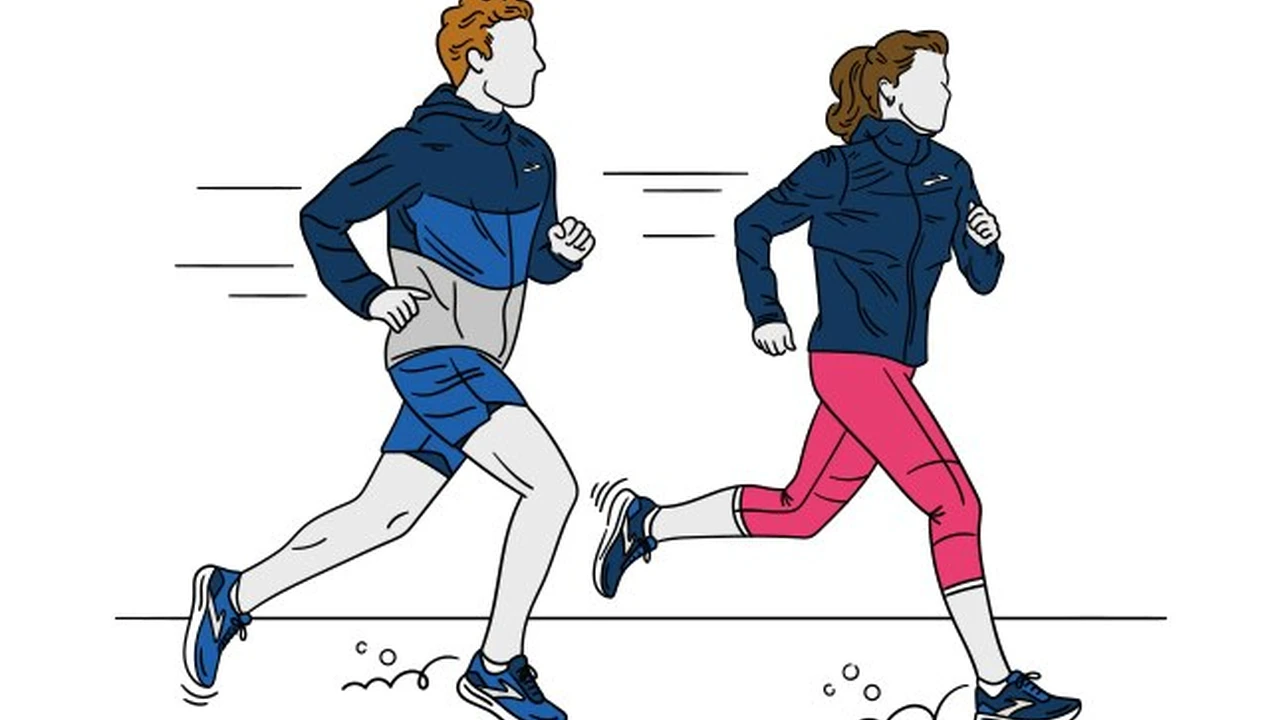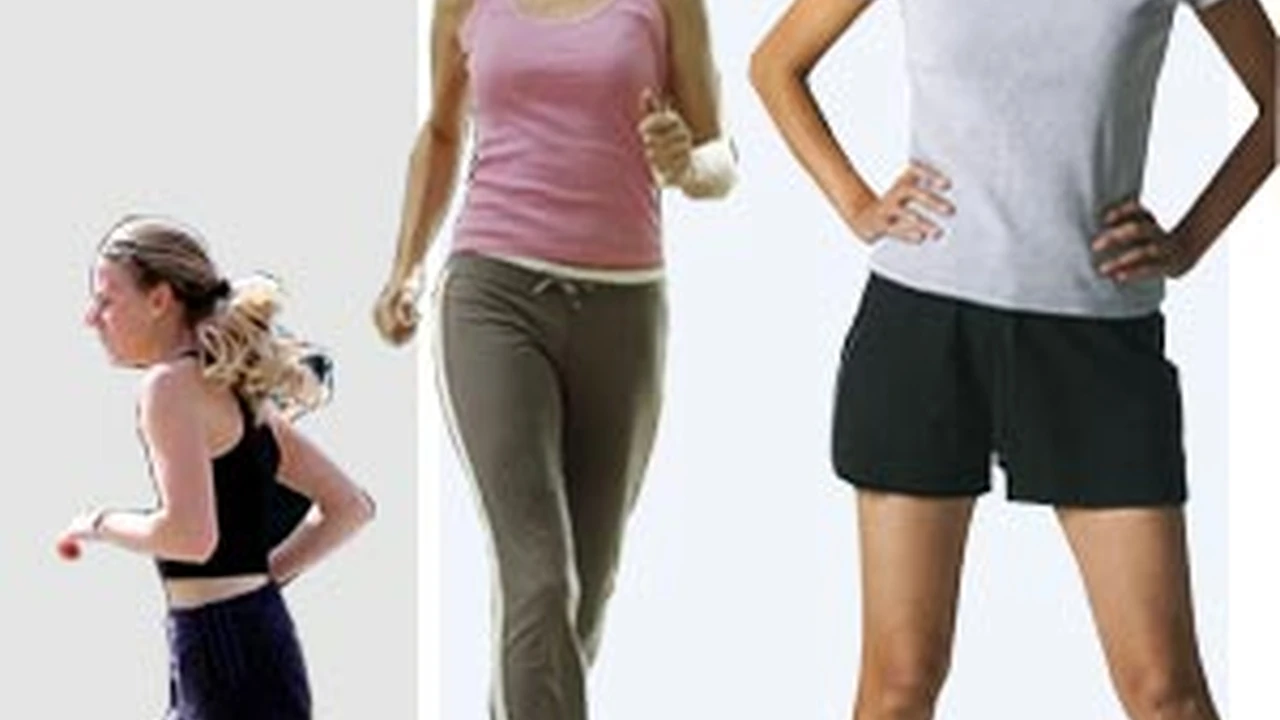Jogging During Pregnancy: What You Need to Know

The Alluring World of Jogging A Beginner's Introduction
So, you're thinking about lacing up those sneakers and hitting the pavement? Excellent choice! Jogging, often seen as the gentler cousin of running, is a fantastic way to improve your cardiovascular health, boost your mood, and explore your surroundings. It's accessible to almost everyone, regardless of age or fitness level. But where do you even begin? Let's break it down.
First, understand the difference between running and jogging. Running generally involves a faster pace where both feet may be off the ground at the same time. Jogging, on the other hand, is a slower, more relaxed pace where at least one foot is always in contact with the ground. This makes it a lower impact activity, which is easier on your joints.
Before you head out the door, consider your current fitness level. If you're completely new to exercise, start with brisk walking and gradually introduce short intervals of jogging. Don't try to do too much too soon, as this can lead to injuries. Listen to your body and take breaks when needed.
Finding the right jogging shoes is crucial. Head to a specialty running store where they can analyze your gait and recommend shoes that provide the right support and cushioning. Don't skimp on this investment – your feet will thank you!
Finally, remember to warm up before each jog and cool down afterwards. A simple warm-up could include dynamic stretches like leg swings, arm circles, and torso twists. A cool-down could involve static stretches like hamstring stretches, quad stretches, and calf stretches. This will help prevent injuries and improve your flexibility.
Essential Jogging Gear for Optimal Performance and Comfort
While jogging itself is a relatively low-cost activity, investing in a few key pieces of gear can significantly enhance your experience. Let's explore some essentials.
The Importance of High Quality Jogging Shoes A Detailed Guide
We touched on jogging shoes earlier, but let's delve deeper. The right shoes can make or break your jogging experience. Consider factors like your foot type (flat feet, high arches, neutral), the terrain you'll be jogging on (pavement, trails), and your running style (heel striker, midfoot striker).
Here are a few popular jogging shoe brands and models:
- Brooks Ghost 14: Known for its excellent cushioning and smooth ride, the Ghost 14 is a great option for neutral runners who primarily jog on pavement. Pricing typically ranges from $130-$150.
- Saucony Kinvara 13: A lightweight and flexible shoe that's ideal for speed work and shorter jogs. The Kinvara 13 offers a responsive feel and is priced around $120-$140.
- Hoka Clifton 8: If you're looking for maximum cushioning, the Hoka Clifton 8 is a top contender. It's incredibly comfortable and provides excellent shock absorption, making it a good choice for runners with sensitive joints. Expect to pay around $140-$160.
- New Balance Fresh Foam 880v12: A versatile shoe that can handle a variety of distances and paces. The Fresh Foam midsole provides a comfortable and supportive ride. Prices range from $130-$150.
Remember to try on shoes in the afternoon or evening, as your feet tend to swell throughout the day. Wear the socks you'll be jogging in and walk around the store to get a feel for the shoes.
The Benefits of Moisture Wicking Apparel Stay Dry and Comfortable
Cotton clothing is a big no-no for jogging. It absorbs sweat and becomes heavy and uncomfortable. Invest in moisture-wicking apparel made from synthetic materials like polyester or nylon. These fabrics wick away sweat, keeping you dry and comfortable.
Look for jogging shirts, shorts, and socks that are specifically designed for running. These garments often feature features like flat seams to prevent chafing and reflective elements for increased visibility.
Popular brands for moisture-wicking apparel include Nike, Adidas, Under Armour, and Lululemon. Prices vary depending on the brand and style.
The Utility of a Fitness Tracker Monitor Your Progress
A fitness tracker can be a valuable tool for tracking your progress and staying motivated. Many fitness trackers can track your distance, pace, heart rate, and calories burned. Some even offer GPS tracking and sleep monitoring.
Here are a few popular fitness trackers:
- Garmin Forerunner 245: A great all-around fitness tracker that offers GPS tracking, heart rate monitoring, and advanced running metrics. It's priced around $300-$350.
- Fitbit Charge 5: A sleek and stylish fitness tracker that tracks your activity levels, sleep, and stress levels. It's priced around $150-$180.
- Apple Watch Series 7: A smartwatch with advanced fitness tracking features, including GPS tracking, heart rate monitoring, and ECG capabilities. It's priced starting at $400.
Consider your budget and needs when choosing a fitness tracker. If you're primarily interested in tracking your running metrics, a dedicated running watch like the Garmin Forerunner 245 may be a better choice. If you want a more versatile device that can also handle calls and notifications, a smartwatch like the Apple Watch Series 7 may be a better fit.
The Importance of Hydration Packs and Water Bottles Stay Hydrated on the Go
Staying hydrated is crucial during any physical activity, especially jogging. Consider carrying a water bottle or hydration pack, especially on longer jogs or in hot weather.
There are many different types of water bottles and hydration packs available. Some water bottles are insulated to keep your water cold, while others are collapsible for easy storage. Hydration packs typically consist of a reservoir of water that you carry on your back, with a tube that allows you to drink hands-free.
Popular brands for water bottles and hydration packs include CamelBak, Hydro Flask, and Nathan.
Proper Jogging Techniques for Injury Prevention and Efficiency
Good form is essential for preventing injuries and maximizing your efficiency while jogging. Here are some key points to keep in mind:
Maintaining Proper Posture While Jogging A Comprehensive Guide
Stand tall with your head up, shoulders relaxed, and core engaged. Avoid slouching or hunching over. Look straight ahead, not down at your feet.
Arm Movement Techniques for Efficient Jogging
Keep your arms bent at a 90-degree angle and swing them forward and back, not across your body. Your hands should be relaxed and close to your body.
Foot Strike and Cadence Optimizing Your Running Stride
Aim to land midfoot, rather than on your heel. This will help reduce the impact on your joints. Maintain a high cadence (the number of steps you take per minute). A cadence of around 170-180 steps per minute is generally considered optimal.
Breathing Techniques for Sustained Jogging Performance
Breathe deeply and rhythmically. Inhale through your nose and exhale through your mouth. Avoid shallow breathing, which can lead to fatigue.
Creating a Jogging Plan Tailored to Your Fitness Goals
Whether you're aiming to lose weight, improve your cardiovascular health, or simply enjoy the outdoors, a well-structured jogging plan can help you achieve your goals.
Setting Realistic Jogging Goals A Step by Step Approach
Start by setting realistic goals. Don't try to do too much too soon. Begin with short, easy jogs and gradually increase the distance and intensity as you get fitter. Consider using a fitness tracker or app to monitor your progress.
Developing a Weekly Jogging Schedule Consistency is Key
Create a weekly jogging schedule that fits your lifestyle. Aim for at least three jogs per week. Be sure to include rest days to allow your body to recover.
Incorporating Interval Training for Enhanced Results
Interval training involves alternating between periods of high-intensity jogging and periods of low-intensity jogging or walking. This can help you improve your speed and endurance.
Tracking Your Progress and Making Adjustments
Keep track of your progress and make adjustments to your plan as needed. If you're not seeing results, you may need to increase the intensity or duration of your jogs.
Nutrition and Hydration Tips for Joggers Fueling Your Body for Success
What you eat and drink can have a significant impact on your jogging performance. Here are some nutrition and hydration tips to keep in mind:
Pre Jogging Meal Ideas for Sustained Energy
Eat a light, easily digestible meal 1-2 hours before jogging. Good options include a banana, a slice of toast with peanut butter, or a small bowl of oatmeal.
Post Jogging Recovery Meals Replenishing Your Energy Stores
Eat a meal or snack that contains both carbohydrates and protein within 30-60 minutes after jogging. This will help replenish your energy stores and repair muscle tissue. Good options include a protein shake, a yogurt with fruit, or a chicken breast with rice.
Hydration Strategies Before During and After Your Jog
Drink plenty of water throughout the day, especially before, during, and after jogging. Consider carrying a water bottle or hydration pack on longer jogs.
Electrolyte Replacement Maintaining Your Body's Balance
If you're jogging for more than an hour, consider consuming an electrolyte drink to replace the electrolytes you lose through sweat. Electrolyte drinks contain sodium, potassium, and other minerals that are essential for maintaining fluid balance.
Common Jogging Injuries Prevention and Treatment
Jogging is a relatively low-impact activity, but injuries can still occur. Here are some common jogging injuries and how to prevent and treat them:
Shin Splints Causes Prevention and Treatment Options
Shin splints are characterized by pain along the shinbone. They are often caused by overuse, improper footwear, or running on hard surfaces. To prevent shin splints, wear supportive shoes, stretch your calf muscles regularly, and gradually increase your mileage.
Runner's Knee Understanding the Symptoms and Treatment
Runner's knee, also known as patellofemoral pain syndrome, is characterized by pain around the kneecap. It is often caused by weak quadriceps muscles, tight hamstrings, or improper running form. To prevent runner's knee, strengthen your quadriceps muscles, stretch your hamstrings regularly, and improve your running form.
Plantar Fasciitis Causes Relief and Long Term Solutions
Plantar fasciitis is characterized by pain in the heel and arch of the foot. It is often caused by overuse, tight calf muscles, or improper footwear. To prevent plantar fasciitis, wear supportive shoes, stretch your calf muscles regularly, and use orthotics if needed.
Ankle Sprains Prevention and Rehabilitation Strategies
Ankle sprains occur when the ligaments that support the ankle are stretched or torn. They are often caused by tripping or twisting the ankle. To prevent ankle sprains, strengthen your ankle muscles, wear supportive shoes, and be careful when running on uneven surfaces.
Jogging for Weight Loss Burning Calories and Shedding Pounds
Jogging can be an effective way to lose weight, as it burns a significant number of calories. Here's how to use jogging for weight loss:
Calorie Expenditure During Jogging Understanding the Numbers
The number of calories you burn during jogging depends on your weight, pace, and duration. A 150-pound person can burn around 300-400 calories per hour of jogging.
Combining Jogging with a Healthy Diet for Optimal Results
To lose weight effectively, combine jogging with a healthy diet. Focus on eating whole, unprocessed foods and limiting your intake of sugary drinks and processed foods.
High Intensity Interval Training HIIT for Increased Fat Burning
High-intensity interval training (HIIT) can be particularly effective for burning fat. HIIT involves alternating between short bursts of high-intensity exercise and periods of low-intensity exercise or rest.
Tracking Your Progress and Staying Motivated
Keep track of your progress and stay motivated by setting realistic goals and rewarding yourself for reaching them.
Jogging for Mental Health Reducing Stress and Boosting Mood
Jogging is not only good for your physical health, but it can also have a positive impact on your mental health. Here's how jogging can improve your mood and reduce stress:
The Release of Endorphins the Natural Mood Booster
Jogging releases endorphins, which are natural mood boosters. Endorphins have pain-relieving and mood-elevating effects.
Reducing Stress and Anxiety Through Physical Activity
Jogging can help reduce stress and anxiety by releasing tension and promoting relaxation.
Improving Sleep Quality for Enhanced Wellbeing
Regular jogging can improve sleep quality, which can have a positive impact on your overall well-being.
Connecting with Nature and Enjoying the Outdoors
Jogging outdoors can provide an opportunity to connect with nature and enjoy the fresh air, which can be beneficial for your mental health.
Jogging with a Buddy or Group Socializing and Motivation
Jogging with a buddy or group can make the experience more enjoyable and motivating. Here are some benefits of jogging with others:
Increased Motivation and Accountability
Jogging with a buddy can help you stay motivated and accountable. You're less likely to skip a jog if you know someone is counting on you.
Social Interaction and Support
Jogging with a group can provide social interaction and support. You can share your experiences and encourage each other.
Safety in Numbers Jogging in Secure Locations
Jogging with a group can be safer, especially in less populated areas.
Exploring New Routes and Locations Together
Jogging with others can provide an opportunity to explore new routes and locations together.
Advanced Jogging Techniques for Experienced Joggers
Once you've been jogging for a while, you may want to try some advanced techniques to challenge yourself and improve your performance:
Hill Training Building Strength and Endurance
Hill training involves running up and down hills. This can help you build strength and endurance.
Tempo Runs Improving Your Lactate Threshold
Tempo runs involve running at a comfortably hard pace for a sustained period of time. This can help you improve your lactate threshold, which is the point at which your body starts to produce lactic acid faster than it can remove it.
Fartlek Training Adding Variety and Speed
Fartlek training involves alternating between periods of fast running and slow running or jogging. This can help you improve your speed and endurance.
Long Runs Building Endurance and Mental Toughness
Long runs involve running for a longer distance than you normally would. This can help you build endurance and mental toughness.
Jogging in Different Weather Conditions Adapting to the Elements
Jogging in different weather conditions can be challenging, but it's important to adapt to the elements to stay safe and comfortable:
Jogging in Hot Weather Staying Cool and Hydrated
In hot weather, wear lightweight, breathable clothing, drink plenty of water, and avoid jogging during the hottest part of the day.
Jogging in Cold Weather Staying Warm and Protected
In cold weather, wear layers of clothing, cover your head and hands, and avoid jogging in windy conditions.
Jogging in Rainy Weather Staying Dry and Safe
In rainy weather, wear waterproof clothing, wear shoes with good traction, and avoid jogging in areas with standing water.
Jogging in Windy Weather Protecting Yourself from the Elements
In windy weather, wear windproof clothing and avoid jogging in exposed areas.
Jogging and Cross Training Complementing Your Routine
Cross-training involves participating in other activities to complement your jogging routine. Here are some benefits of cross-training:
Strength Training Building Muscle and Preventing Injuries
Strength training can help you build muscle and prevent injuries. Focus on exercises that target your legs, core, and upper body.
Swimming Low Impact Cardio and Muscle Recovery
Swimming is a low-impact activity that can help you improve your cardiovascular health and recover from tough jogs.
Cycling Another Great Cardio Option
Cycling is another great cardio option that can help you improve your endurance and strengthen your legs.
Yoga and Stretching Improving Flexibility and Balance
Yoga and stretching can help you improve your flexibility and balance, which can reduce your risk of injuries.
The Future of Jogging Technology and Trends
The world of jogging is constantly evolving with new technology and trends. Here are some things to watch out for:
Advancements in Running Shoe Technology
Running shoe technology is constantly improving, with new materials and designs that can enhance performance and reduce the risk of injuries.
The Rise of Wearable Technology Tracking Your Performance
Wearable technology, such as fitness trackers and smartwatches, is becoming increasingly popular for tracking jogging performance and providing personalized feedback.
Virtual Running and Online Communities Connecting with Others
Virtual running and online communities are making it easier to connect with other joggers and participate in virtual races.
Sustainable Running Practices Reducing Your Environmental Impact
Sustainable running practices, such as using recycled materials and reducing waste, are becoming increasingly important as people become more aware of the environmental impact of their activities.
:max_bytes(150000):strip_icc()/277019-baked-pork-chops-with-cream-of-mushroom-soup-DDMFS-beauty-4x3-BG-7505-5762b731cf30447d9cbbbbbf387beafa.jpg)






